Personal and Professional Skills for Management
VerifiedAdded on 2023/01/05
|9
|2690
|97
AI Summary
This report discusses the importance of personal and professional skills for effective management in the workplace. It focuses on conflict management techniques and coaching techniques for individual performance. The case study of Tesco, a multinational grocery company, is used to provide insights into these topics.
Contribute Materials
Your contribution can guide someone’s learning journey. Share your
documents today.
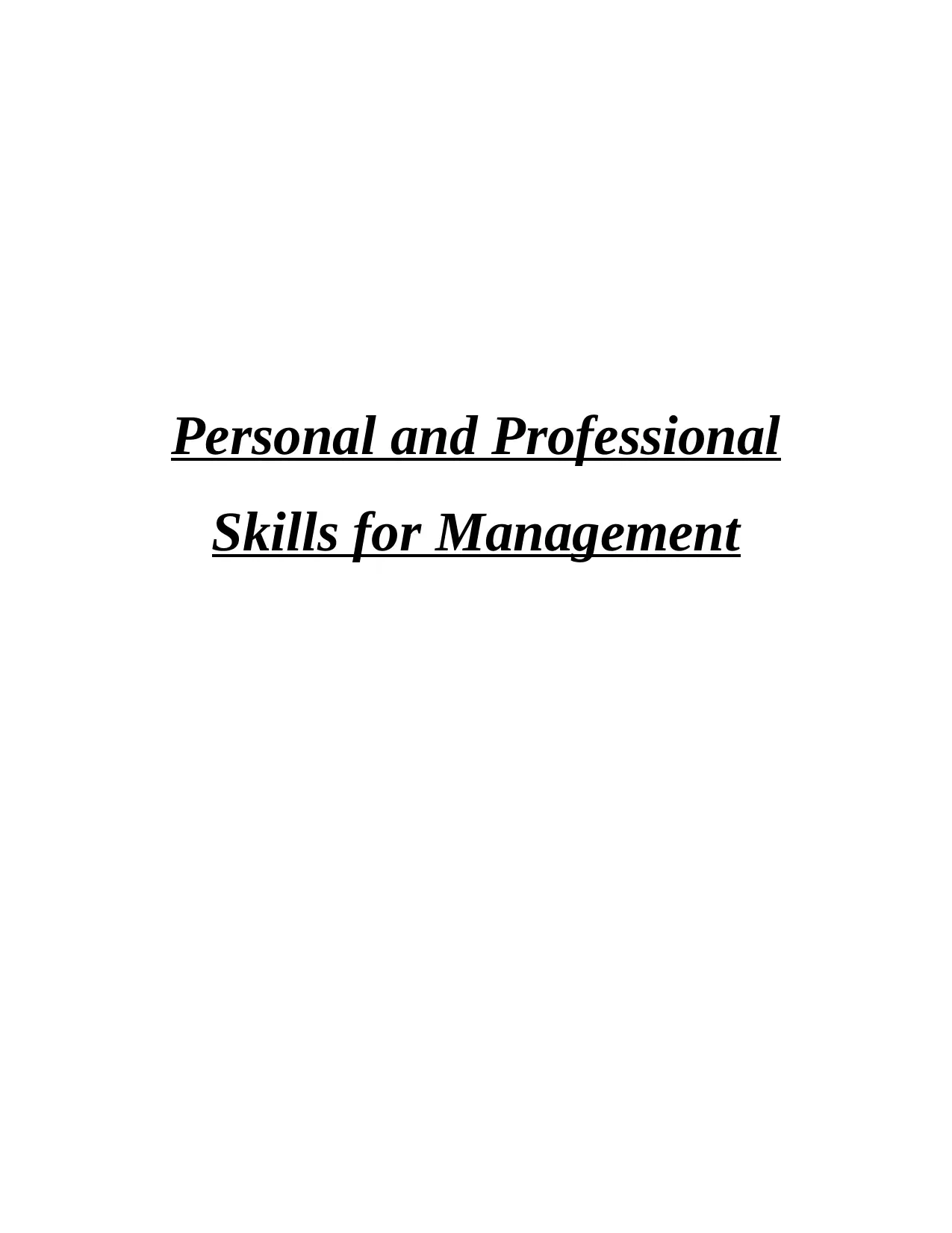
Personal and Professional
Skills for Management
Skills for Management
Secure Best Marks with AI Grader
Need help grading? Try our AI Grader for instant feedback on your assignments.
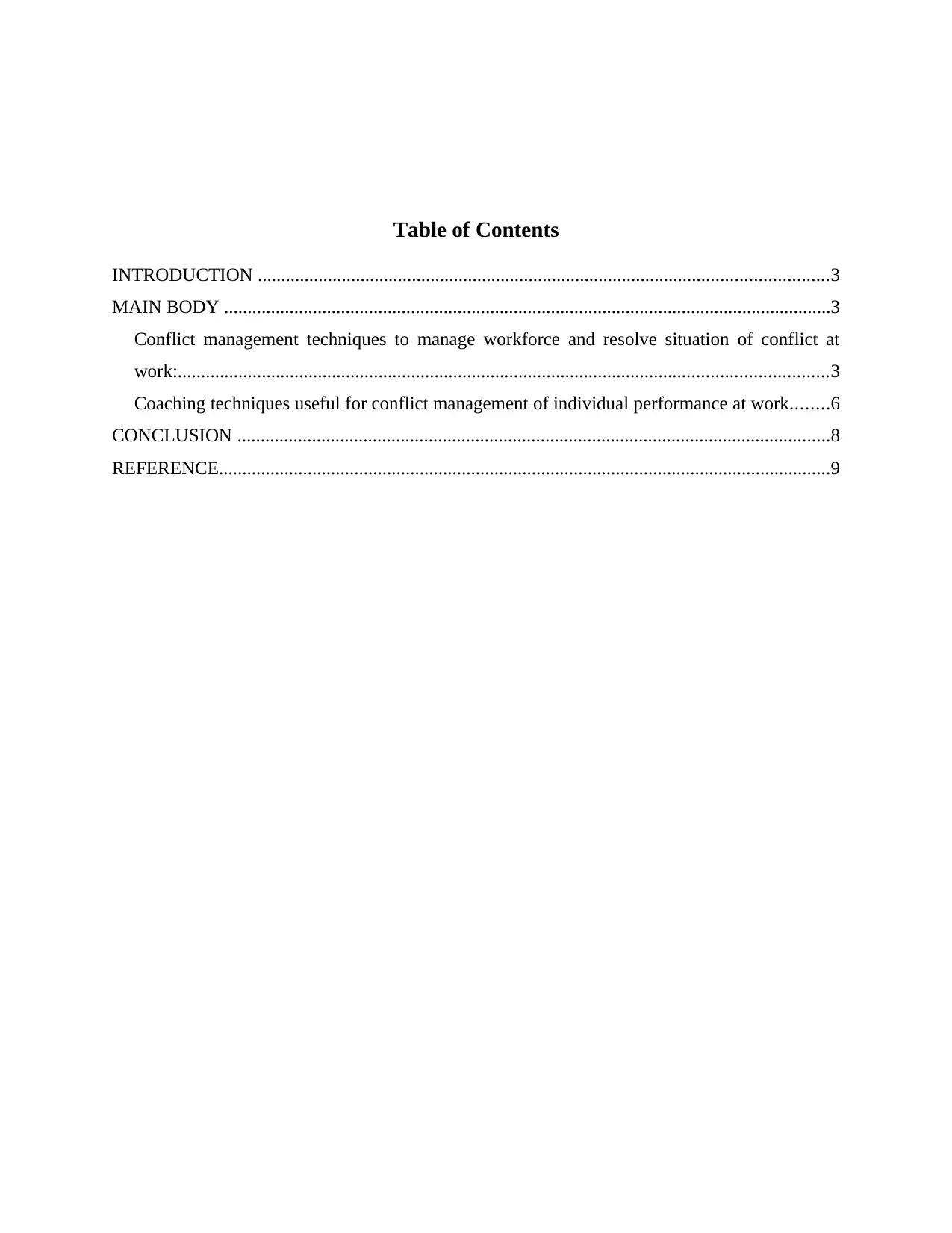
Table of Contents
INTRODUCTION ..........................................................................................................................3
MAIN BODY ..................................................................................................................................3
Conflict management techniques to manage workforce and resolve situation of conflict at
work:...........................................................................................................................................3
Coaching techniques useful for conflict management of individual performance at work........6
CONCLUSION ...............................................................................................................................8
REFERENCE...................................................................................................................................9
INTRODUCTION ..........................................................................................................................3
MAIN BODY ..................................................................................................................................3
Conflict management techniques to manage workforce and resolve situation of conflict at
work:...........................................................................................................................................3
Coaching techniques useful for conflict management of individual performance at work........6
CONCLUSION ...............................................................................................................................8
REFERENCE...................................................................................................................................9
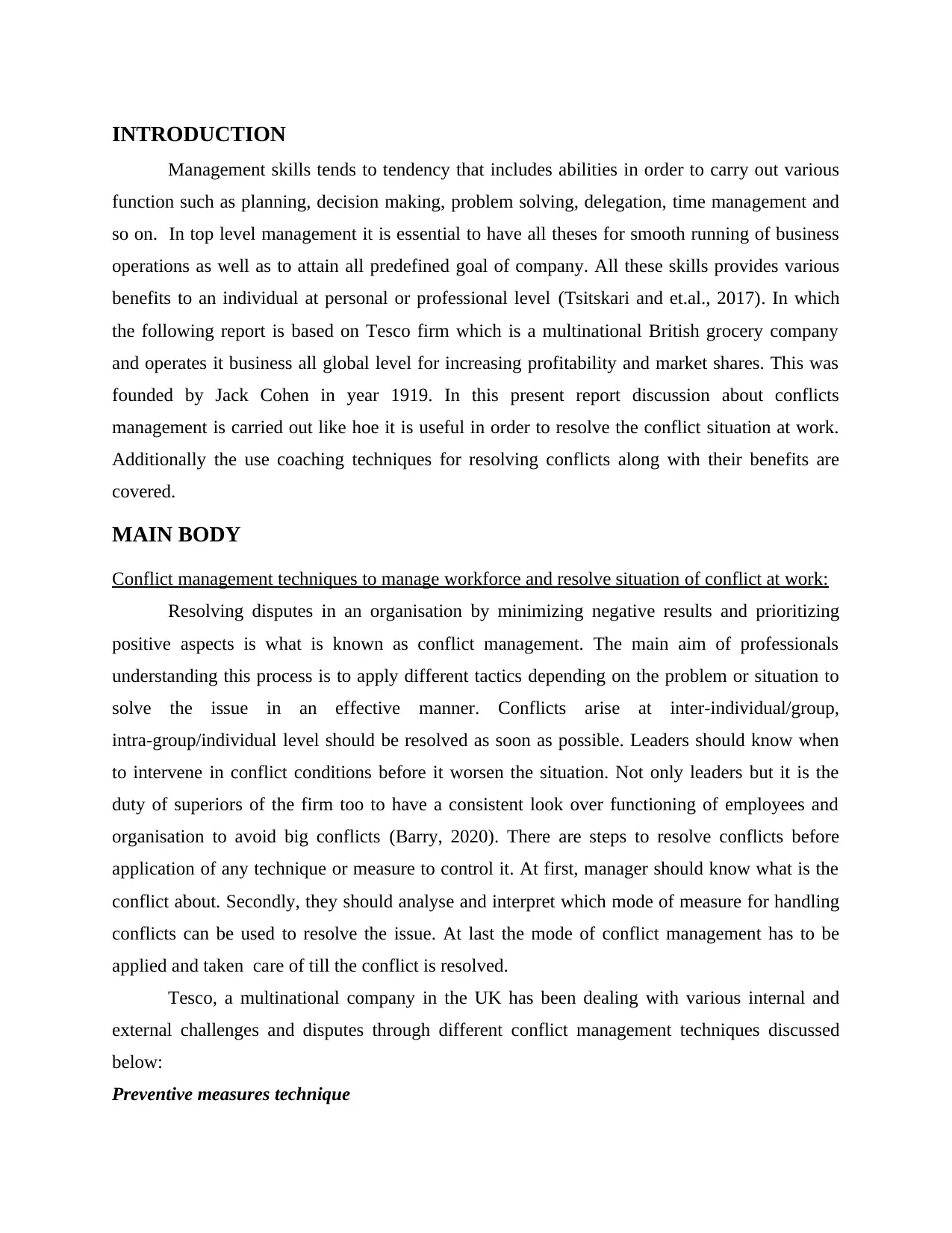
INTRODUCTION
Management skills tends to tendency that includes abilities in order to carry out various
function such as planning, decision making, problem solving, delegation, time management and
so on. In top level management it is essential to have all theses for smooth running of business
operations as well as to attain all predefined goal of company. All these skills provides various
benefits to an individual at personal or professional level (Tsitskari and et.al., 2017). In which
the following report is based on Tesco firm which is a multinational British grocery company
and operates it business all global level for increasing profitability and market shares. This was
founded by Jack Cohen in year 1919. In this present report discussion about conflicts
management is carried out like hoe it is useful in order to resolve the conflict situation at work.
Additionally the use coaching techniques for resolving conflicts along with their benefits are
covered.
MAIN BODY
Conflict management techniques to manage workforce and resolve situation of conflict at work:
Resolving disputes in an organisation by minimizing negative results and prioritizing
positive aspects is what is known as conflict management. The main aim of professionals
understanding this process is to apply different tactics depending on the problem or situation to
solve the issue in an effective manner. Conflicts arise at inter-individual/group,
intra-group/individual level should be resolved as soon as possible. Leaders should know when
to intervene in conflict conditions before it worsen the situation. Not only leaders but it is the
duty of superiors of the firm too to have a consistent look over functioning of employees and
organisation to avoid big conflicts (Barry, 2020). There are steps to resolve conflicts before
application of any technique or measure to control it. At first, manager should know what is the
conflict about. Secondly, they should analyse and interpret which mode of measure for handling
conflicts can be used to resolve the issue. At last the mode of conflict management has to be
applied and taken care of till the conflict is resolved.
Tesco, a multinational company in the UK has been dealing with various internal and
external challenges and disputes through different conflict management techniques discussed
below:
Preventive measures technique
Management skills tends to tendency that includes abilities in order to carry out various
function such as planning, decision making, problem solving, delegation, time management and
so on. In top level management it is essential to have all theses for smooth running of business
operations as well as to attain all predefined goal of company. All these skills provides various
benefits to an individual at personal or professional level (Tsitskari and et.al., 2017). In which
the following report is based on Tesco firm which is a multinational British grocery company
and operates it business all global level for increasing profitability and market shares. This was
founded by Jack Cohen in year 1919. In this present report discussion about conflicts
management is carried out like hoe it is useful in order to resolve the conflict situation at work.
Additionally the use coaching techniques for resolving conflicts along with their benefits are
covered.
MAIN BODY
Conflict management techniques to manage workforce and resolve situation of conflict at work:
Resolving disputes in an organisation by minimizing negative results and prioritizing
positive aspects is what is known as conflict management. The main aim of professionals
understanding this process is to apply different tactics depending on the problem or situation to
solve the issue in an effective manner. Conflicts arise at inter-individual/group,
intra-group/individual level should be resolved as soon as possible. Leaders should know when
to intervene in conflict conditions before it worsen the situation. Not only leaders but it is the
duty of superiors of the firm too to have a consistent look over functioning of employees and
organisation to avoid big conflicts (Barry, 2020). There are steps to resolve conflicts before
application of any technique or measure to control it. At first, manager should know what is the
conflict about. Secondly, they should analyse and interpret which mode of measure for handling
conflicts can be used to resolve the issue. At last the mode of conflict management has to be
applied and taken care of till the conflict is resolved.
Tesco, a multinational company in the UK has been dealing with various internal and
external challenges and disputes through different conflict management techniques discussed
below:
Preventive measures technique
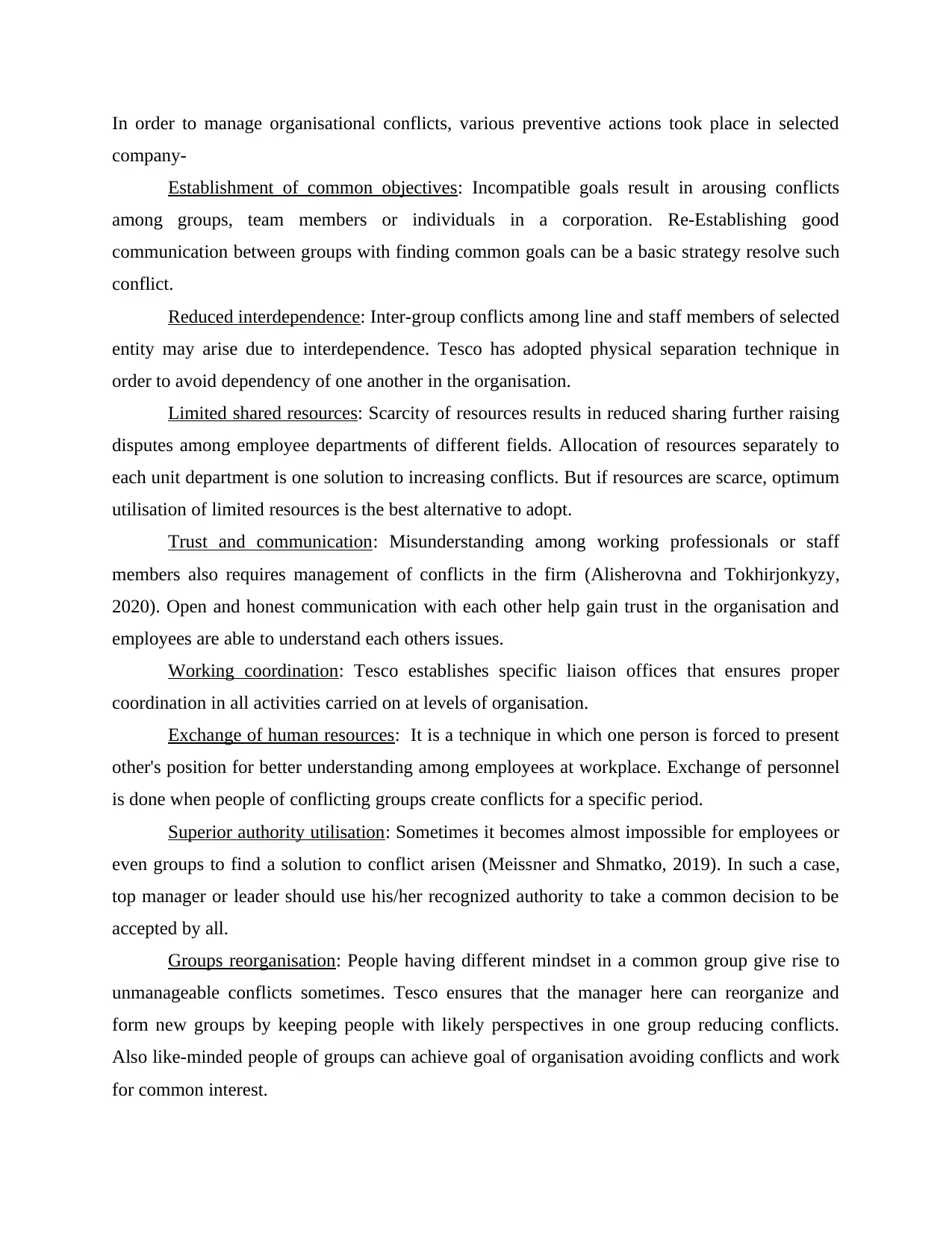
In order to manage organisational conflicts, various preventive actions took place in selected
company-
Establishment of common objectives: Incompatible goals result in arousing conflicts
among groups, team members or individuals in a corporation. Re-Establishing good
communication between groups with finding common goals can be a basic strategy resolve such
conflict.
Reduced interdependence: Inter-group conflicts among line and staff members of selected
entity may arise due to interdependence. Tesco has adopted physical separation technique in
order to avoid dependency of one another in the organisation.
Limited shared resources: Scarcity of resources results in reduced sharing further raising
disputes among employee departments of different fields. Allocation of resources separately to
each unit department is one solution to increasing conflicts. But if resources are scarce, optimum
utilisation of limited resources is the best alternative to adopt.
Trust and communication: Misunderstanding among working professionals or staff
members also requires management of conflicts in the firm (Alisherovna and Tokhirjonkyzy,
2020). Open and honest communication with each other help gain trust in the organisation and
employees are able to understand each others issues.
Working coordination: Tesco establishes specific liaison offices that ensures proper
coordination in all activities carried on at levels of organisation.
Exchange of human resources: It is a technique in which one person is forced to present
other's position for better understanding among employees at workplace. Exchange of personnel
is done when people of conflicting groups create conflicts for a specific period.
Superior authority utilisation: Sometimes it becomes almost impossible for employees or
even groups to find a solution to conflict arisen (Meissner and Shmatko, 2019). In such a case,
top manager or leader should use his/her recognized authority to take a common decision to be
accepted by all.
Groups reorganisation: People having different mindset in a common group give rise to
unmanageable conflicts sometimes. Tesco ensures that the manager here can reorganize and
form new groups by keeping people with likely perspectives in one group reducing conflicts.
Also like-minded people of groups can achieve goal of organisation avoiding conflicts and work
for common interest.
company-
Establishment of common objectives: Incompatible goals result in arousing conflicts
among groups, team members or individuals in a corporation. Re-Establishing good
communication between groups with finding common goals can be a basic strategy resolve such
conflict.
Reduced interdependence: Inter-group conflicts among line and staff members of selected
entity may arise due to interdependence. Tesco has adopted physical separation technique in
order to avoid dependency of one another in the organisation.
Limited shared resources: Scarcity of resources results in reduced sharing further raising
disputes among employee departments of different fields. Allocation of resources separately to
each unit department is one solution to increasing conflicts. But if resources are scarce, optimum
utilisation of limited resources is the best alternative to adopt.
Trust and communication: Misunderstanding among working professionals or staff
members also requires management of conflicts in the firm (Alisherovna and Tokhirjonkyzy,
2020). Open and honest communication with each other help gain trust in the organisation and
employees are able to understand each others issues.
Working coordination: Tesco establishes specific liaison offices that ensures proper
coordination in all activities carried on at levels of organisation.
Exchange of human resources: It is a technique in which one person is forced to present
other's position for better understanding among employees at workplace. Exchange of personnel
is done when people of conflicting groups create conflicts for a specific period.
Superior authority utilisation: Sometimes it becomes almost impossible for employees or
even groups to find a solution to conflict arisen (Meissner and Shmatko, 2019). In such a case,
top manager or leader should use his/her recognized authority to take a common decision to be
accepted by all.
Groups reorganisation: People having different mindset in a common group give rise to
unmanageable conflicts sometimes. Tesco ensures that the manager here can reorganize and
form new groups by keeping people with likely perspectives in one group reducing conflicts.
Also like-minded people of groups can achieve goal of organisation avoiding conflicts and work
for common interest.
Secure Best Marks with AI Grader
Need help grading? Try our AI Grader for instant feedback on your assignments.
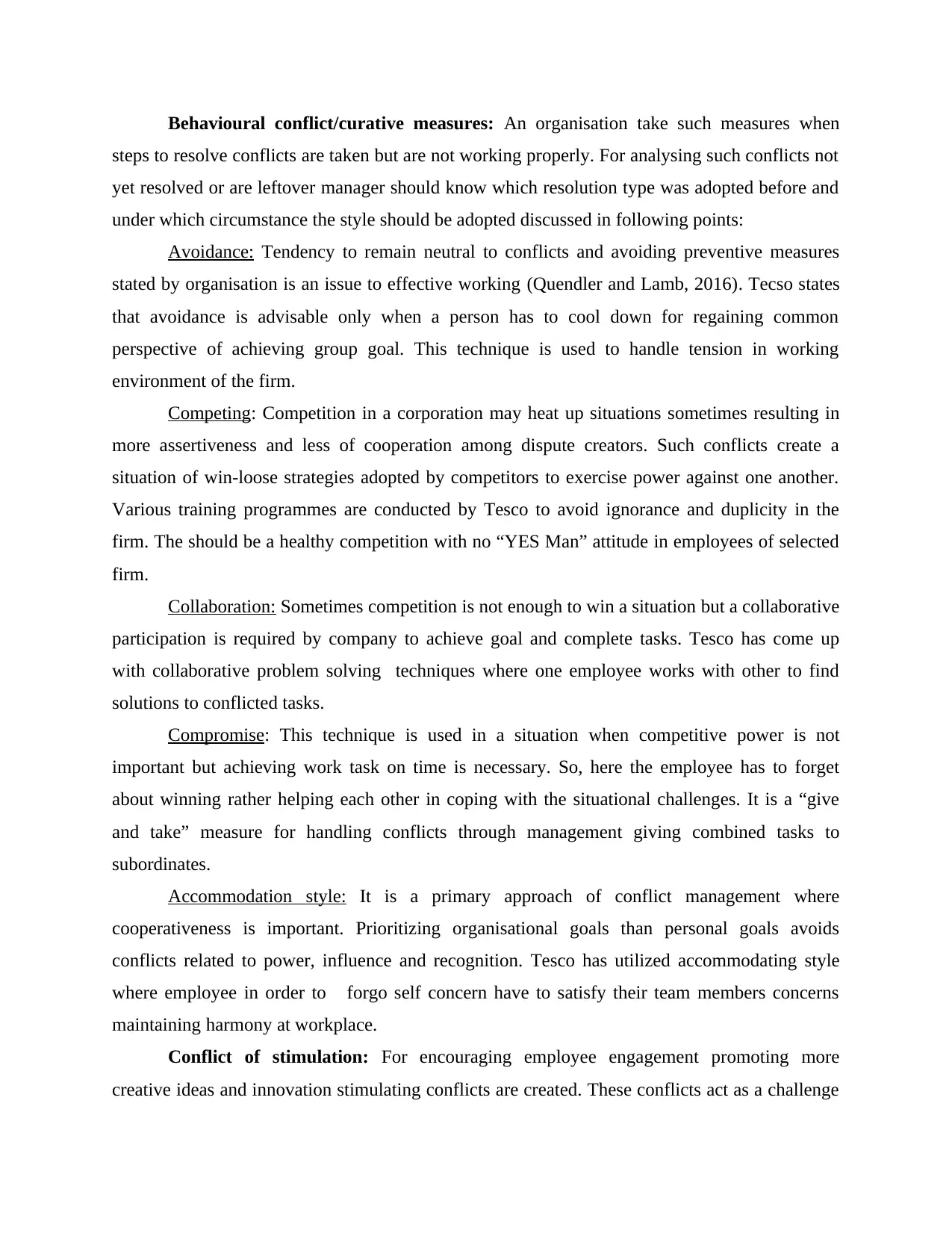
Behavioural conflict/curative measures: An organisation take such measures when
steps to resolve conflicts are taken but are not working properly. For analysing such conflicts not
yet resolved or are leftover manager should know which resolution type was adopted before and
under which circumstance the style should be adopted discussed in following points:
Avoidance: Tendency to remain neutral to conflicts and avoiding preventive measures
stated by organisation is an issue to effective working (Quendler and Lamb, 2016). Tecso states
that avoidance is advisable only when a person has to cool down for regaining common
perspective of achieving group goal. This technique is used to handle tension in working
environment of the firm.
Competing: Competition in a corporation may heat up situations sometimes resulting in
more assertiveness and less of cooperation among dispute creators. Such conflicts create a
situation of win-loose strategies adopted by competitors to exercise power against one another.
Various training programmes are conducted by Tesco to avoid ignorance and duplicity in the
firm. The should be a healthy competition with no “YES Man” attitude in employees of selected
firm.
Collaboration: Sometimes competition is not enough to win a situation but a collaborative
participation is required by company to achieve goal and complete tasks. Tesco has come up
with collaborative problem solving techniques where one employee works with other to find
solutions to conflicted tasks.
Compromise: This technique is used in a situation when competitive power is not
important but achieving work task on time is necessary. So, here the employee has to forget
about winning rather helping each other in coping with the situational challenges. It is a “give
and take” measure for handling conflicts through management giving combined tasks to
subordinates.
Accommodation style: It is a primary approach of conflict management where
cooperativeness is important. Prioritizing organisational goals than personal goals avoids
conflicts related to power, influence and recognition. Tesco has utilized accommodating style
where employee in order to forgo self concern have to satisfy their team members concerns
maintaining harmony at workplace.
Conflict of stimulation: For encouraging employee engagement promoting more
creative ideas and innovation stimulating conflicts are created. These conflicts act as a challenge
steps to resolve conflicts are taken but are not working properly. For analysing such conflicts not
yet resolved or are leftover manager should know which resolution type was adopted before and
under which circumstance the style should be adopted discussed in following points:
Avoidance: Tendency to remain neutral to conflicts and avoiding preventive measures
stated by organisation is an issue to effective working (Quendler and Lamb, 2016). Tecso states
that avoidance is advisable only when a person has to cool down for regaining common
perspective of achieving group goal. This technique is used to handle tension in working
environment of the firm.
Competing: Competition in a corporation may heat up situations sometimes resulting in
more assertiveness and less of cooperation among dispute creators. Such conflicts create a
situation of win-loose strategies adopted by competitors to exercise power against one another.
Various training programmes are conducted by Tesco to avoid ignorance and duplicity in the
firm. The should be a healthy competition with no “YES Man” attitude in employees of selected
firm.
Collaboration: Sometimes competition is not enough to win a situation but a collaborative
participation is required by company to achieve goal and complete tasks. Tesco has come up
with collaborative problem solving techniques where one employee works with other to find
solutions to conflicted tasks.
Compromise: This technique is used in a situation when competitive power is not
important but achieving work task on time is necessary. So, here the employee has to forget
about winning rather helping each other in coping with the situational challenges. It is a “give
and take” measure for handling conflicts through management giving combined tasks to
subordinates.
Accommodation style: It is a primary approach of conflict management where
cooperativeness is important. Prioritizing organisational goals than personal goals avoids
conflicts related to power, influence and recognition. Tesco has utilized accommodating style
where employee in order to forgo self concern have to satisfy their team members concerns
maintaining harmony at workplace.
Conflict of stimulation: For encouraging employee engagement promoting more
creative ideas and innovation stimulating conflicts are created. These conflicts act as a challenge
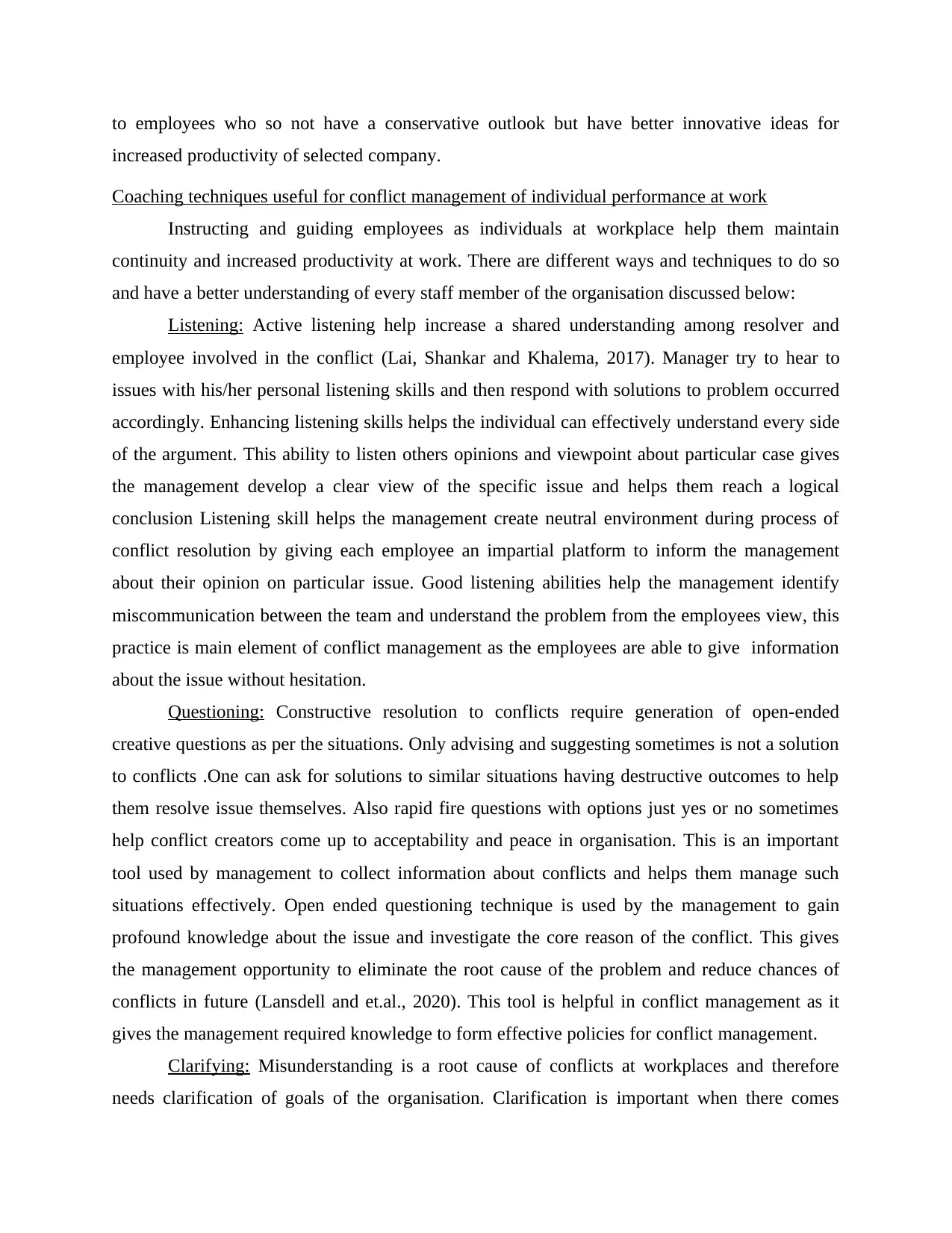
to employees who so not have a conservative outlook but have better innovative ideas for
increased productivity of selected company.
Coaching techniques useful for conflict management of individual performance at work
Instructing and guiding employees as individuals at workplace help them maintain
continuity and increased productivity at work. There are different ways and techniques to do so
and have a better understanding of every staff member of the organisation discussed below:
Listening: Active listening help increase a shared understanding among resolver and
employee involved in the conflict (Lai, Shankar and Khalema, 2017). Manager try to hear to
issues with his/her personal listening skills and then respond with solutions to problem occurred
accordingly. Enhancing listening skills helps the individual can effectively understand every side
of the argument. This ability to listen others opinions and viewpoint about particular case gives
the management develop a clear view of the specific issue and helps them reach a logical
conclusion Listening skill helps the management create neutral environment during process of
conflict resolution by giving each employee an impartial platform to inform the management
about their opinion on particular issue. Good listening abilities help the management identify
miscommunication between the team and understand the problem from the employees view, this
practice is main element of conflict management as the employees are able to give information
about the issue without hesitation.
Questioning: Constructive resolution to conflicts require generation of open-ended
creative questions as per the situations. Only advising and suggesting sometimes is not a solution
to conflicts .One can ask for solutions to similar situations having destructive outcomes to help
them resolve issue themselves. Also rapid fire questions with options just yes or no sometimes
help conflict creators come up to acceptability and peace in organisation. This is an important
tool used by management to collect information about conflicts and helps them manage such
situations effectively. Open ended questioning technique is used by the management to gain
profound knowledge about the issue and investigate the core reason of the conflict. This gives
the management opportunity to eliminate the root cause of the problem and reduce chances of
conflicts in future (Lansdell and et.al., 2020). This tool is helpful in conflict management as it
gives the management required knowledge to form effective policies for conflict management.
Clarifying: Misunderstanding is a root cause of conflicts at workplaces and therefore
needs clarification of goals of the organisation. Clarification is important when there comes
increased productivity of selected company.
Coaching techniques useful for conflict management of individual performance at work
Instructing and guiding employees as individuals at workplace help them maintain
continuity and increased productivity at work. There are different ways and techniques to do so
and have a better understanding of every staff member of the organisation discussed below:
Listening: Active listening help increase a shared understanding among resolver and
employee involved in the conflict (Lai, Shankar and Khalema, 2017). Manager try to hear to
issues with his/her personal listening skills and then respond with solutions to problem occurred
accordingly. Enhancing listening skills helps the individual can effectively understand every side
of the argument. This ability to listen others opinions and viewpoint about particular case gives
the management develop a clear view of the specific issue and helps them reach a logical
conclusion Listening skill helps the management create neutral environment during process of
conflict resolution by giving each employee an impartial platform to inform the management
about their opinion on particular issue. Good listening abilities help the management identify
miscommunication between the team and understand the problem from the employees view, this
practice is main element of conflict management as the employees are able to give information
about the issue without hesitation.
Questioning: Constructive resolution to conflicts require generation of open-ended
creative questions as per the situations. Only advising and suggesting sometimes is not a solution
to conflicts .One can ask for solutions to similar situations having destructive outcomes to help
them resolve issue themselves. Also rapid fire questions with options just yes or no sometimes
help conflict creators come up to acceptability and peace in organisation. This is an important
tool used by management to collect information about conflicts and helps them manage such
situations effectively. Open ended questioning technique is used by the management to gain
profound knowledge about the issue and investigate the core reason of the conflict. This gives
the management opportunity to eliminate the root cause of the problem and reduce chances of
conflicts in future (Lansdell and et.al., 2020). This tool is helpful in conflict management as it
gives the management required knowledge to form effective policies for conflict management.
Clarifying: Misunderstanding is a root cause of conflicts at workplaces and therefore
needs clarification of goals of the organisation. Clarification is important when there comes
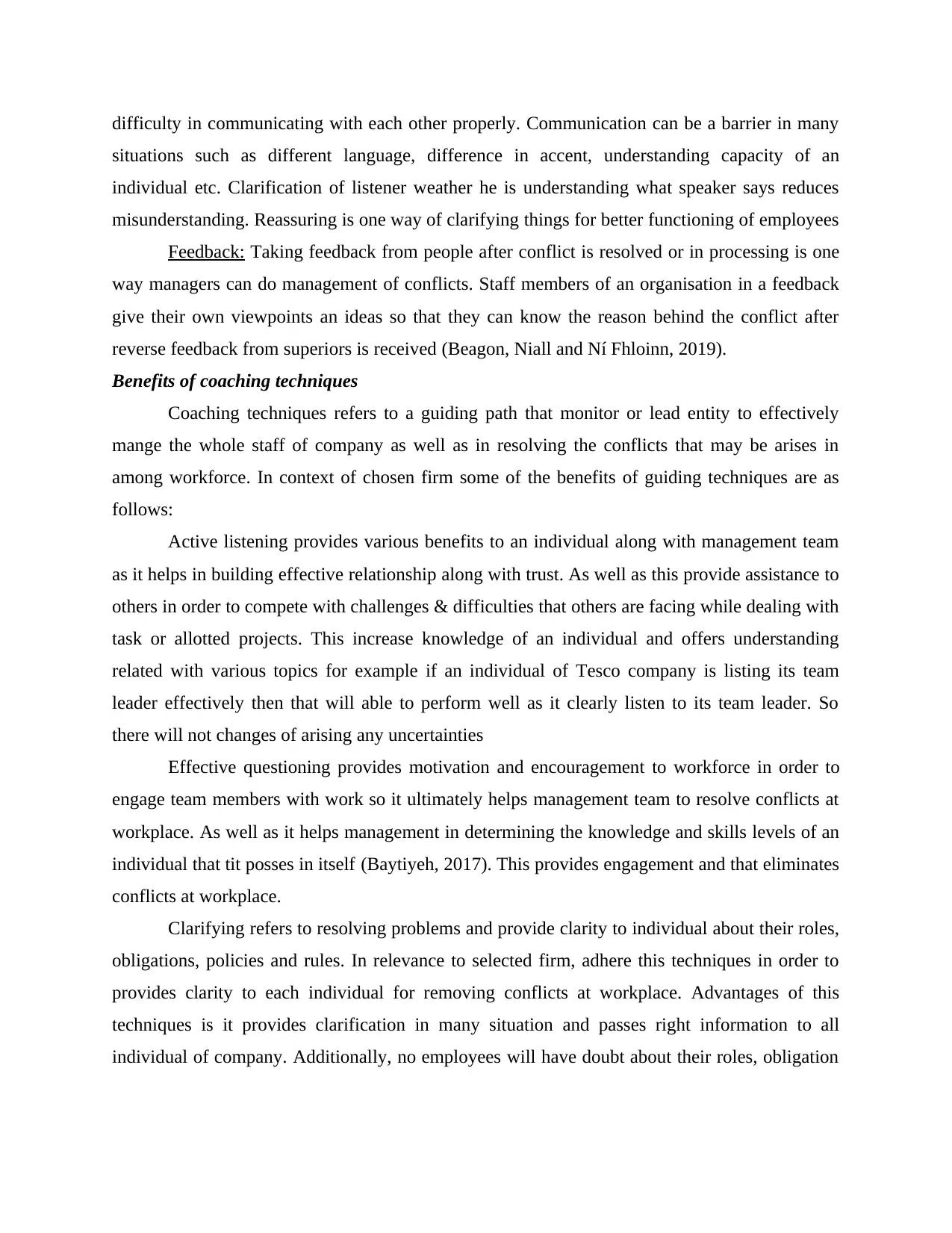
difficulty in communicating with each other properly. Communication can be a barrier in many
situations such as different language, difference in accent, understanding capacity of an
individual etc. Clarification of listener weather he is understanding what speaker says reduces
misunderstanding. Reassuring is one way of clarifying things for better functioning of employees
Feedback: Taking feedback from people after conflict is resolved or in processing is one
way managers can do management of conflicts. Staff members of an organisation in a feedback
give their own viewpoints an ideas so that they can know the reason behind the conflict after
reverse feedback from superiors is received (Beagon, Niall and Ní Fhloinn, 2019).
Benefits of coaching techniques
Coaching techniques refers to a guiding path that monitor or lead entity to effectively
mange the whole staff of company as well as in resolving the conflicts that may be arises in
among workforce. In context of chosen firm some of the benefits of guiding techniques are as
follows:
Active listening provides various benefits to an individual along with management team
as it helps in building effective relationship along with trust. As well as this provide assistance to
others in order to compete with challenges & difficulties that others are facing while dealing with
task or allotted projects. This increase knowledge of an individual and offers understanding
related with various topics for example if an individual of Tesco company is listing its team
leader effectively then that will able to perform well as it clearly listen to its team leader. So
there will not changes of arising any uncertainties
Effective questioning provides motivation and encouragement to workforce in order to
engage team members with work so it ultimately helps management team to resolve conflicts at
workplace. As well as it helps management in determining the knowledge and skills levels of an
individual that tit posses in itself (Baytiyeh, 2017). This provides engagement and that eliminates
conflicts at workplace.
Clarifying refers to resolving problems and provide clarity to individual about their roles,
obligations, policies and rules. In relevance to selected firm, adhere this techniques in order to
provides clarity to each individual for removing conflicts at workplace. Advantages of this
techniques is it provides clarification in many situation and passes right information to all
individual of company. Additionally, no employees will have doubt about their roles, obligation
situations such as different language, difference in accent, understanding capacity of an
individual etc. Clarification of listener weather he is understanding what speaker says reduces
misunderstanding. Reassuring is one way of clarifying things for better functioning of employees
Feedback: Taking feedback from people after conflict is resolved or in processing is one
way managers can do management of conflicts. Staff members of an organisation in a feedback
give their own viewpoints an ideas so that they can know the reason behind the conflict after
reverse feedback from superiors is received (Beagon, Niall and Ní Fhloinn, 2019).
Benefits of coaching techniques
Coaching techniques refers to a guiding path that monitor or lead entity to effectively
mange the whole staff of company as well as in resolving the conflicts that may be arises in
among workforce. In context of chosen firm some of the benefits of guiding techniques are as
follows:
Active listening provides various benefits to an individual along with management team
as it helps in building effective relationship along with trust. As well as this provide assistance to
others in order to compete with challenges & difficulties that others are facing while dealing with
task or allotted projects. This increase knowledge of an individual and offers understanding
related with various topics for example if an individual of Tesco company is listing its team
leader effectively then that will able to perform well as it clearly listen to its team leader. So
there will not changes of arising any uncertainties
Effective questioning provides motivation and encouragement to workforce in order to
engage team members with work so it ultimately helps management team to resolve conflicts at
workplace. As well as it helps management in determining the knowledge and skills levels of an
individual that tit posses in itself (Baytiyeh, 2017). This provides engagement and that eliminates
conflicts at workplace.
Clarifying refers to resolving problems and provide clarity to individual about their roles,
obligations, policies and rules. In relevance to selected firm, adhere this techniques in order to
provides clarity to each individual for removing conflicts at workplace. Advantages of this
techniques is it provides clarification in many situation and passes right information to all
individual of company. Additionally, no employees will have doubt about their roles, obligation
Paraphrase This Document
Need a fresh take? Get an instant paraphrase of this document with our AI Paraphraser
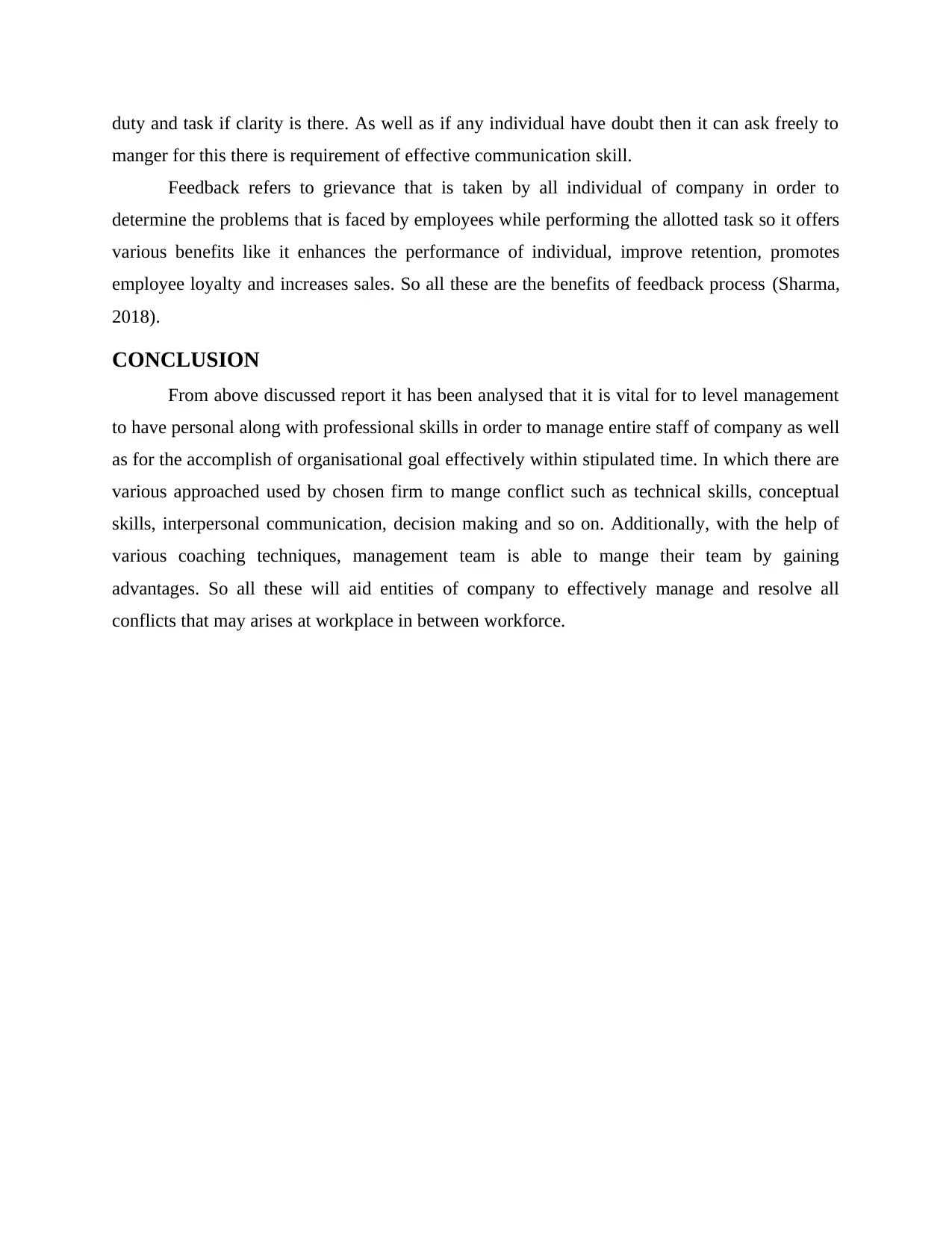
duty and task if clarity is there. As well as if any individual have doubt then it can ask freely to
manger for this there is requirement of effective communication skill.
Feedback refers to grievance that is taken by all individual of company in order to
determine the problems that is faced by employees while performing the allotted task so it offers
various benefits like it enhances the performance of individual, improve retention, promotes
employee loyalty and increases sales. So all these are the benefits of feedback process (Sharma,
2018).
CONCLUSION
From above discussed report it has been analysed that it is vital for to level management
to have personal along with professional skills in order to manage entire staff of company as well
as for the accomplish of organisational goal effectively within stipulated time. In which there are
various approached used by chosen firm to mange conflict such as technical skills, conceptual
skills, interpersonal communication, decision making and so on. Additionally, with the help of
various coaching techniques, management team is able to mange their team by gaining
advantages. So all these will aid entities of company to effectively manage and resolve all
conflicts that may arises at workplace in between workforce.
manger for this there is requirement of effective communication skill.
Feedback refers to grievance that is taken by all individual of company in order to
determine the problems that is faced by employees while performing the allotted task so it offers
various benefits like it enhances the performance of individual, improve retention, promotes
employee loyalty and increases sales. So all these are the benefits of feedback process (Sharma,
2018).
CONCLUSION
From above discussed report it has been analysed that it is vital for to level management
to have personal along with professional skills in order to manage entire staff of company as well
as for the accomplish of organisational goal effectively within stipulated time. In which there are
various approached used by chosen firm to mange conflict such as technical skills, conceptual
skills, interpersonal communication, decision making and so on. Additionally, with the help of
various coaching techniques, management team is able to mange their team by gaining
advantages. So all these will aid entities of company to effectively manage and resolve all
conflicts that may arises at workplace in between workforce.
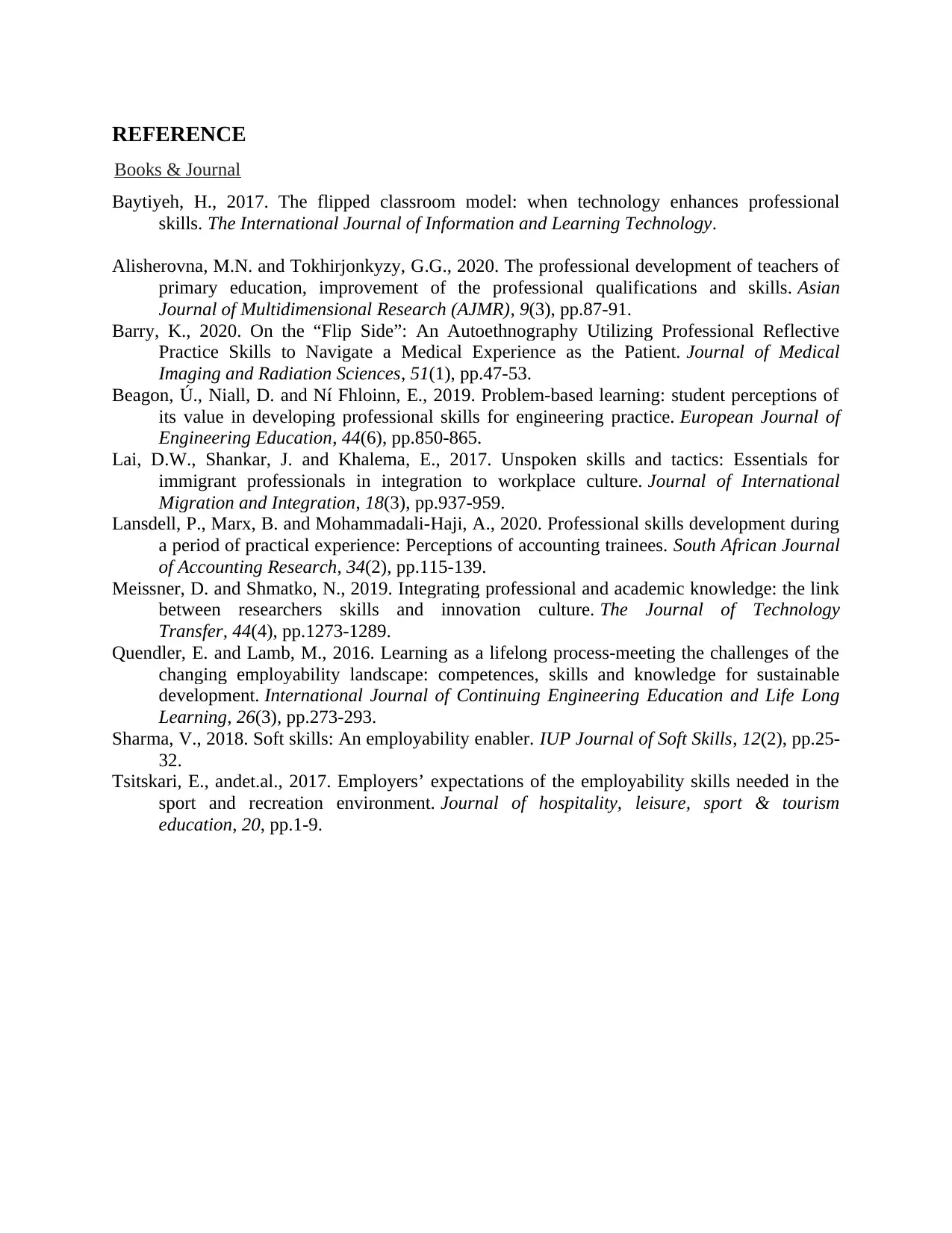
REFERENCE
Books & Journal
Baytiyeh, H., 2017. The flipped classroom model: when technology enhances professional
skills. The International Journal of Information and Learning Technology.
Alisherovna, M.N. and Tokhirjonkyzy, G.G., 2020. The professional development of teachers of
primary education, improvement of the professional qualifications and skills. Asian
Journal of Multidimensional Research (AJMR), 9(3), pp.87-91.
Barry, K., 2020. On the “Flip Side”: An Autoethnography Utilizing Professional Reflective
Practice Skills to Navigate a Medical Experience as the Patient. Journal of Medical
Imaging and Radiation Sciences, 51(1), pp.47-53.
Beagon, Ú., Niall, D. and Ní Fhloinn, E., 2019. Problem-based learning: student perceptions of
its value in developing professional skills for engineering practice. European Journal of
Engineering Education, 44(6), pp.850-865.
Lai, D.W., Shankar, J. and Khalema, E., 2017. Unspoken skills and tactics: Essentials for
immigrant professionals in integration to workplace culture. Journal of International
Migration and Integration, 18(3), pp.937-959.
Lansdell, P., Marx, B. and Mohammadali-Haji, A., 2020. Professional skills development during
a period of practical experience: Perceptions of accounting trainees. South African Journal
of Accounting Research, 34(2), pp.115-139.
Meissner, D. and Shmatko, N., 2019. Integrating professional and academic knowledge: the link
between researchers skills and innovation culture. The Journal of Technology
Transfer, 44(4), pp.1273-1289.
Quendler, E. and Lamb, M., 2016. Learning as a lifelong process-meeting the challenges of the
changing employability landscape: competences, skills and knowledge for sustainable
development. International Journal of Continuing Engineering Education and Life Long
Learning, 26(3), pp.273-293.
Sharma, V., 2018. Soft skills: An employability enabler. IUP Journal of Soft Skills, 12(2), pp.25-
32.
Tsitskari, E., andet.al., 2017. Employers’ expectations of the employability skills needed in the
sport and recreation environment. Journal of hospitality, leisure, sport & tourism
education, 20, pp.1-9.
Books & Journal
Baytiyeh, H., 2017. The flipped classroom model: when technology enhances professional
skills. The International Journal of Information and Learning Technology.
Alisherovna, M.N. and Tokhirjonkyzy, G.G., 2020. The professional development of teachers of
primary education, improvement of the professional qualifications and skills. Asian
Journal of Multidimensional Research (AJMR), 9(3), pp.87-91.
Barry, K., 2020. On the “Flip Side”: An Autoethnography Utilizing Professional Reflective
Practice Skills to Navigate a Medical Experience as the Patient. Journal of Medical
Imaging and Radiation Sciences, 51(1), pp.47-53.
Beagon, Ú., Niall, D. and Ní Fhloinn, E., 2019. Problem-based learning: student perceptions of
its value in developing professional skills for engineering practice. European Journal of
Engineering Education, 44(6), pp.850-865.
Lai, D.W., Shankar, J. and Khalema, E., 2017. Unspoken skills and tactics: Essentials for
immigrant professionals in integration to workplace culture. Journal of International
Migration and Integration, 18(3), pp.937-959.
Lansdell, P., Marx, B. and Mohammadali-Haji, A., 2020. Professional skills development during
a period of practical experience: Perceptions of accounting trainees. South African Journal
of Accounting Research, 34(2), pp.115-139.
Meissner, D. and Shmatko, N., 2019. Integrating professional and academic knowledge: the link
between researchers skills and innovation culture. The Journal of Technology
Transfer, 44(4), pp.1273-1289.
Quendler, E. and Lamb, M., 2016. Learning as a lifelong process-meeting the challenges of the
changing employability landscape: competences, skills and knowledge for sustainable
development. International Journal of Continuing Engineering Education and Life Long
Learning, 26(3), pp.273-293.
Sharma, V., 2018. Soft skills: An employability enabler. IUP Journal of Soft Skills, 12(2), pp.25-
32.
Tsitskari, E., andet.al., 2017. Employers’ expectations of the employability skills needed in the
sport and recreation environment. Journal of hospitality, leisure, sport & tourism
education, 20, pp.1-9.
1 out of 9
Related Documents
Your All-in-One AI-Powered Toolkit for Academic Success.
+13062052269
info@desklib.com
Available 24*7 on WhatsApp / Email
![[object Object]](/_next/static/media/star-bottom.7253800d.svg)
Unlock your academic potential
© 2024 | Zucol Services PVT LTD | All rights reserved.




